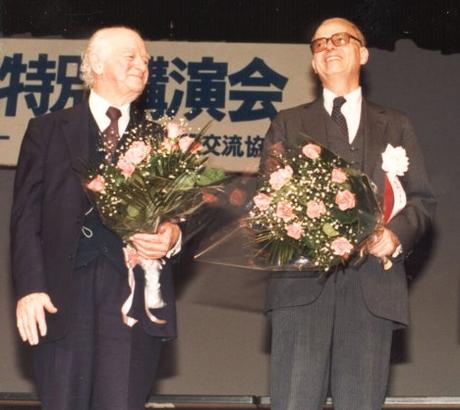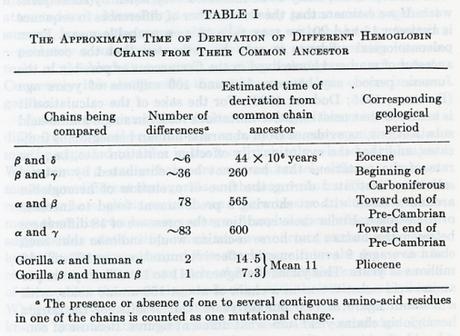
Linus Pauling and Emile Zuckerkandl, 1986.
[Part 1 of 2]
“Of all natural systems, living matter is the one which, in the face of great transformations, preserves inscribed in its organization the largest amount of its own past history. We may ask the question: Where in the now living systems has the greatest amount of their past history survived, and how it can be extracted?”
-Linus Pauling and Emile Zuckerkandl, 1964
Austria-born Emile Zuckerkandl fled to Paris with his parents to escape the Nazi occupation of his homeland when he was only sixteen. Twenty years Linus Pauling’s junior, this extraordinary scientific mind was nurtured through the study of the biological sciences at the University of Illinois in the United States, and the Paris-Sorbonne University in France. During the course of these studies, Zuckerkandl developed a particularly keen interest in the molecular aspects of physiology and biology, and is now regarded to have been a major contributor to both fields.
Zuckerkandl first met Linus Pauling in 1957, a time period during Pauling himself was spearheading the new study of molecular disease, following his earlier, groundbreaking discovery of the genetic basis of sickle cell anemia. Two years later, Zuckerkandl joined Pauling as a post-doc in the Chemistry and Chemical Engineering Division at the California Institute of Technology. Once arrived, Zuckerkandl was encouraged by Pauling to study the evolution of hemoglobin, a research project that was informed by a basic and crucial assumption that the rate of mutational change in the genome is effectively constant over time.
This assumption was something of a hard sell for biologists at the time, due to the prevailing belief within the discipline that mutations were effectively random. Undaunted, Pauling and Zuckerkandl moved forward with their project and ultimately created a model that, over time, ushered in major changes to the conventional wisdom.
The Pauling-Zuckerkandl project was first revealed to the world in a co-authored paper that appeared in 1962’s Horizons in Biochemistry, a volume of works written and dedicated to the Nobel winning physiologist Albert Szent-Györgyi. The paper, titled “Molecular Disease, Evolution, and Genic Heterogeneity,” is regarded today as a foundational work in its application of molecular and genetic techniques to the study of evolution.
At the time that Pauling and Zuckerkandl wrote this first joint paper, Pauling was, as the title of the work might suggest, very interested in molecular disease; so much so that he was thinking about molecular disease and evolution as occupying two sides of the same coin. Defining life as “a relationship between molecules, not a property of any one molecule,” Pauling believed that disease, insofar as it was molecular in basis, could be defined in exactly the same way. Since both evolution and molecular disease were merely expressions of relationships between molecules, the distinction between the two became blurred for Pauling, who felt that the mechanism of molecular disease represented one element of the mechanism of evolution.
In their paper, Pauling and Zuckerkandl outlined their point of view as follows:
Subjectively, to evolve must most often have amounted to suffering from a disease. And these diseases were of course molecular. …[T]he notion of molecular disease relates exclusively to the inheritance of altered protein and nucleic acid molecules. An abnormal protein causing molecular disease has abnormal enzymatic or other physicochemical properties. Changes in such properties are necessarily linked to changes in structure. The study of molecular diseases leads back to the study of mutations, most of which are known to be detrimental. A bacterium that loses by mutation the ability to synthesize a given enzyme has a molecular disease. The first heterotrophic organisms suffered from a molecular disease, of which they cured themselves by feeding on their fellow creatures. At the limit, life itself is a molecular disease, which it overcomes temporarily by depending on its environment.
These assertions – in particular that “life itself” was a molecular disease – were so strange and seemingly outrageous that many biologists dismissed the paper outright. However, the basic idea that the pair was considering simultaneously sparked the interest of many other scientists who willing to entertain the consequences of this mode of thinking. If Pauling and Zuckerkandl were right, then every vitamin required by human beings stood as a witness bearing testimony to the molecular diseases that our ancestors contracted hundreds of millions of years ago. These “diseases” would manifest negative symptoms only when the curative properties of the nutrients gained from our natural environment through food and drink proved insufficient to dampen their effects.
This line of reasoning provided the impetus for Pauling and Zuckerkandl to begin examining differences between the genetic code as a tool to better understand evolutionary history. Though they did not call it “the molecular clock” at the time, the concept served as the foundation for the genetic analysis of species over long periods of evolutionary history.
Fundamental to Pauling and Zuckerkandl’s argument was the notion that there was no reason to place molecules at specific points “higher” or “lower” on an evolutionary scale. Horse hemoglobin, for example, is not less organized or complex than is human hemoglobin, it is simply different. The same is true for the genetic information contained in the hemoglobin of humans as compared to other primates, such as gorillas.
As Zuckerkandl examined differences of these sorts, he was not surprised to find that the peptide sequences of a gorilla were more similar to a human’s than a horse’s were to either. He and Pauling then began to consider how these sequences must be indicative of the millions of years of separate evolution that had passed since the disappearance of the last common ancestor linking horses and primates.
While compelling in its own right, for Pauling the chief purpose of understanding these differences was to discern crucial information about the human condition and to define the parameters of optimal health. Indeed, Pauling fundamentally believed that an improved understanding of the transitions that the genetic code had undergone would ultimately reveal new and effective treatments for molecular diseases.

Table I from Pauling and Zukerkandl’s 1962 paper.
To demonstrate the efficacy of their methodology, Pauling and Zuckerkandl calculated the number of genetic differences that exist between the alpha and beta chains of hemoglobin peptide sequences in horses, humans, and gorillas, which they then used to determine the time that had elapsed since the erasure of the last common ancestor linking these species. In seeming support of their claims, the authors found that their figures matched pretty closely with data uncovered by paleontologists.
Despite this, the impact of Pauling and Zuckerkandl’s paper dissipated pretty quickly. For other established figures in the field, Pauling and Zukerkandl had failed to prove the essential assumption that evolution should proceed with relative uniformity over time. Lacking a clear reason to accept that genetic change occurs at a constant rate, there was no compelling reason to believe that Pauling and Zuckerkandl’s molecular clock should give an accurate picture of evolutionary history.
Nonetheless, the idea of the molecular clock found a degree of traction among biologists who valued its potential to corroborate and increase the accuracy of existing phylogenetic assignments. And as we’ll discuss in our next post, Pauling and Zuckerkandl continued to explore their ideas, eventually building a body of work that came into far greater favor a few decades later.
Advertisements